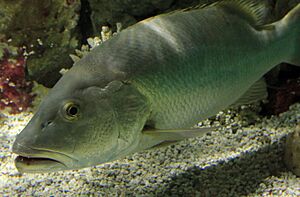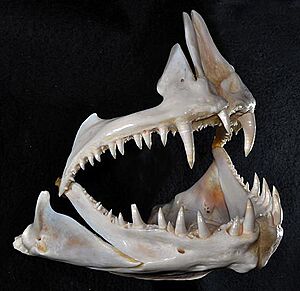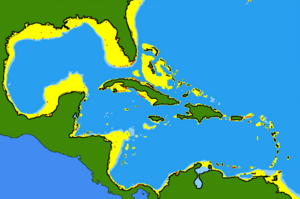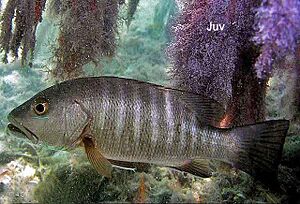Cubera snapper facts for kids
Quick facts for kids Cubera snapper |
|
|---|---|
 |
|
 |
|
| Conservation status | |
| Scientific classification | |
 |
|
| Synonyms | |
|
The cubera snapper (Lutjanus cyanopterus), also known as the Cuban snapper, is a large fish that lives in the ocean. It's part of the snapper family, called Lutjanidae. You can find it in the western part of the Atlantic Ocean. People like to catch this fish for food and for sport. Sometimes, eating larger cubera snappers can make people sick, so it's important to know where they come from.
Contents
About Its Name
The cubera snapper was first officially named in 1828. A French scientist named Georges Cuvier gave it the name Mesoprion cyanopterus. The second part of its scientific name, cyanopterus, comes from two Greek words. 'Cyano' means blue, and 'pterus' means fin. This is because Cuvier noticed the fish had bluish-black fins.
What Does It Look Like?
The cubera snapper has a body shape that is long and oval, like a torpedo. It's not as tall as some other snapper fish. It has two sets of nostrils on its snout, which are simple holes. Its mouth is quite big with thick lips.
Inside its mouth, it has strong, pointed teeth, like a dog's canine teeth. You can even see one large pair of these teeth when its mouth is closed! The fins are also special. It has long pectoral fins on its sides. Its top fin, called the dorsal fin, is one long fin. The tail fin is flat at the end.
A cubera snapper can grow up to 160 centimeters (about 5 feet) long. But most of them are around 90 centimeters (about 3 feet). The heaviest one ever recorded weighed about 57 kilograms (125 pounds).
Their color is usually grey to dark brown. Their sides might be lighter or darker grey. Some cubera snappers can even have a slight reddish color. Their tail fin is light grey, and their other fins can look bluish. Young cubera snappers have faint stripes on their sides.
Where Do They Live?
Cubera snappers live in the western Atlantic Ocean. You can find them from Nova Scotia in the north all the way down to Brazil in the south. They also live throughout the Caribbean Sea and the Gulf of Mexico, and near Bermuda. They usually live in waters between 1 and 85 meters (about 3 to 280 feet) deep.
Young cubera snappers like to hide in beds of sea grass close to shore. They can also be found in mangrove areas. Sometimes, they even swim into fresh water! As they get older, the adult fish move further out into the ocean. They prefer to live near rocky ledges and coral reefs.
How Do They Live?
Adult cubera snappers usually live alone. They can live for a very long time, up to 55 years!
What Do They Eat?
The cubera snapper is the biggest type of snapper. It's a predator, which means it hunts other animals for food. They mostly eat other fish. But they also enjoy eating large crustaceans, like lobsters and crabs. Their strong canine teeth help them grab and eat these hard-shelled animals. They usually look for food near the ocean floor or around rocky places.
Smaller cubera snappers can become food for other animals. Whale sharks eat their eggs. Larger cubera snappers can be hunted by moray eels, barracudas, groupers, other snappers, and sharks.
How Do They Reproduce?
Cubera snappers lay their eggs from May to August. During this time, many of them gather together in large groups to spawn. These gatherings are linked to the lunar cycles, meaning they happen around certain moon phases.
They meet in huge numbers, sometimes up to 10,000 fish! They gather in shallow areas offshore, like on the slopes of outer reefs or sandy drop-offs. The eggs hatch within a day after they are fertilized. The tiny baby fish then float with the ocean currents until they are ready to settle down.
Fishing and Protecting Them
Cubera snappers are considered good to eat. However, larger fish from some areas can cause a type of food poisoning called ciguatera. This is why people in places like Puerto Rico might not eat the bigger fish. In the Florida Keys, people might only eat the smaller ones.
People catch cubera snappers using fishing lines with hooks, large nets, or by spearfishing. Because they gather in large, predictable groups to lay eggs, they are easy to catch. This makes them vulnerable to being overfished.
In the United States, there are rules about how many cubera snappers can be caught and how big they must be. Despite these rules, the number of cubera snappers has gone down a lot. For example, along the Atlantic coast of the United States, the catch decreased by over 60% in 20 years up to 2015. The numbers of fish spawning near Cuba and Brazil have also dropped. In some parts of Brazil, there are so few cubera snappers left that it's no longer worth fishing for them.
The IUCN (International Union for Conservation of Nature) believes that the numbers will keep going down unless these fish gatherings are protected. Because of this, they have listed the cubera snapper as a vulnerable species. This means it's at risk of becoming endangered if we don't protect it.



